Ultimate Guide on Aluminum Profile for LED Strip Lighting
Aluminum is melted and extruded to obtain aluminum materials with different cross-sectional shapes, hence the name extruded aluminum channel (also known as aluminum extrusions, aluminum channels, and aluminum profiles).
As a crucial part of linear LED fixture, the aluminum extrusions are compatible with LED strip lights of any color and color temperature. It also acts as the main resource in terms of thermal management of the LED strips, which can extend the LED strip life.
There are different types and different sharps of the aluminum channels to adapt to different applications, commercial lighting, cabinet display lighting, office lighting, and home lighting.

Different Types of LED Aluminum Profiles
A complete aluminum profile accessories include led light strip diffuser(led strip light cover), aluminum channel, end caps, and mounting clips.
When you choosing the LED aluminum channels, you need to consider the following points.

1. LED channel diffuser
The LED channel diffuser takes the function of improving the lighting effect of the LED lights, allowing the LED light distribution more even, so as not to hurt the human's eyes and achieve better LED lighting effect.
The diffuser of these two materials(PC and PMMA) we sell is different, each of which has a different light-emitting effect, so pay attention to distinguishing when choosing the LED strip lighting channel.
Some led channel diffusers can be curled, bendable into a circle, while some only are straight.
| PC Diffuser (Transparent, Opal) | PMMA Diffuser (Transparent, Semi-clear, Opal) | ||
| Pros | Cons | Pros | Cons |
|
• Impact resistant. • Flame retardant materials, not easy to burn. • Environmentally friendly plastics. • UV resistant. • Flexible. |
• Easy to crack. • Higher gloss surface. • Large wear coefficient. • Larger tendency of high temperature thermal deformation. |
• Weather resistance (outdoor aging resistance). • Good transparency. |
• Low surface hardness. • Easy to scratch. |
The light transmittance of different led light strip diffuser is different. Choose the right diffuser according the lighting effect you want.
|
►Transparent — 85-95% light transmittance. For maximum brightness, this diffuser will not provide spotless light effects. ►Semi-clear — 70-80% light transmittance. Brightness is important but not necessary. ►Opal matte/milky — 30-40% light transmittance. The most unlikely diffuser to be found when the light strip is illuminated. |
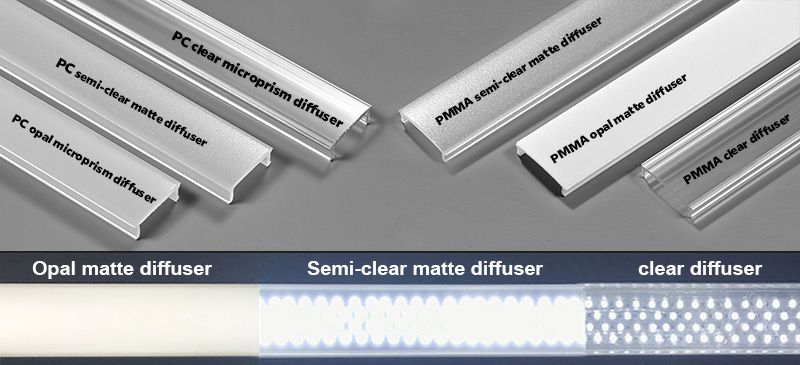
How to use the LED channel diffuser?
There are two protruding parts at the end where the diffuser is inserted into the aluminum groove, which can be firmly inserted into the aluminum channel by pressing. It can also be slid into the aluminum channel according to the shape.

2. LED aluminum channel
 Aluminum Channel Color: sliver, white, and black aluminum.
Aluminum Channel Color: sliver, white, and black aluminum.
As an important part of LED linear illumination, the aluminum profiles have good decorative properties and the surface is finely oxidized. It can be drawn in different colors.
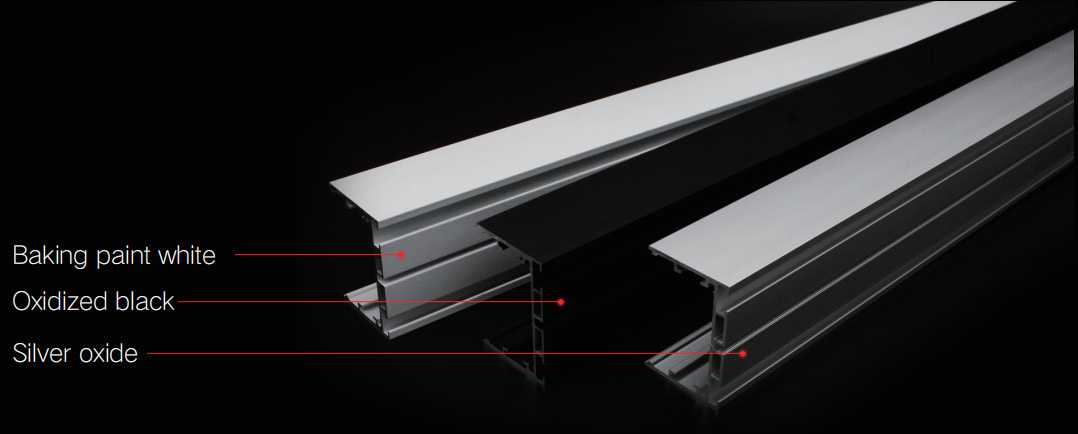
 Aluminum Profile Shape: U shape, circle, corner, and other special shapes.
Aluminum Profile Shape: U shape, circle, corner, and other special shapes.
Most aluminum profiles are U-shaped called aluminum U channel, of course, there are other shapes to meet different installation needs, such as circle, corner, and other special shapes.
Each aluminum profile has its specific purpose, and different aluminum profiles are suitable for different installation occasions.
The following two shapes of the aluminum U channel are commonly used in LED strip lighting projects, like our lastest motion sensor LED stair light kit.
The second shape is called LED aluminum channel with flange. The function of the flange is to cover the gap between the embedded aluminum profile and the reserved size when recessing the aluminum channel in plaster or furniture.

 Aluminum Channel Sizes: Aluminum channel dimensions include height, width, and length.
Aluminum Channel Sizes: Aluminum channel dimensions include height, width, and length.
The higher the aluminum channel height, the farther the light strip is from the diffuser, and the more even the LED light is diffused.
And the LED strip density (the distance between two LEDs) will also affect the uniformity lighting effect. High-density light strips have a more uniform light distribution than low-density light strips in the aluminum channel.
More uniform light distribution means that the LED light effect is less spotless.
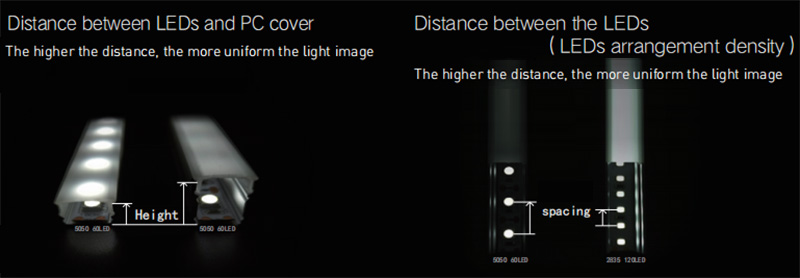
When determining the aluminum channel sizes, the aluminum width must be wider than the width of the light strip PCB to ensure that the LED strip can be placed in the aluminum channel. Note the width refer to the aluminum inner width, aluminum channel outter width, or the LED strip PCB width.
For example, choosing an 8mm width aluminum channel for your 10mm PCB strip is incorrect.
The standard length of the aluminum profile is 1 meter, 2 meters, and 3 meters. Long aluminum channel is not easy to transport, and it is prone to accidents during transportation. And so the higher cost you will spend.
For the needs of ultra-long aluminum channels, we recommend splicing multiple aluminum channels together. The gap between the two aluminum channels is within 0.5mm, and there is no trace from a distance.

3. End Caps
There are two end caps for one meter of the LED strip aluminum profile, one end cap has a hole for the light strip wire to pass through, and one end cap has no hole.
The end caps seal the aluminum channel to protect the light strip from damage and dust and moisture.
The aluminum profile all-plastic tube-type sealing structure can achieve IP65 waterproof level after being glued with the silicone plug.
4. Mounting clips
Fixing the aluminum channel is inseparable from the mounting clips, and the one-meter aluminum channel is equipped with two mounting clips.
Aluminum channel extrusions mounting clips include: stainless steel clips, PC buckles, spring clips, rotating bracket, rotating bracket, suspension bracket, pendant kit.
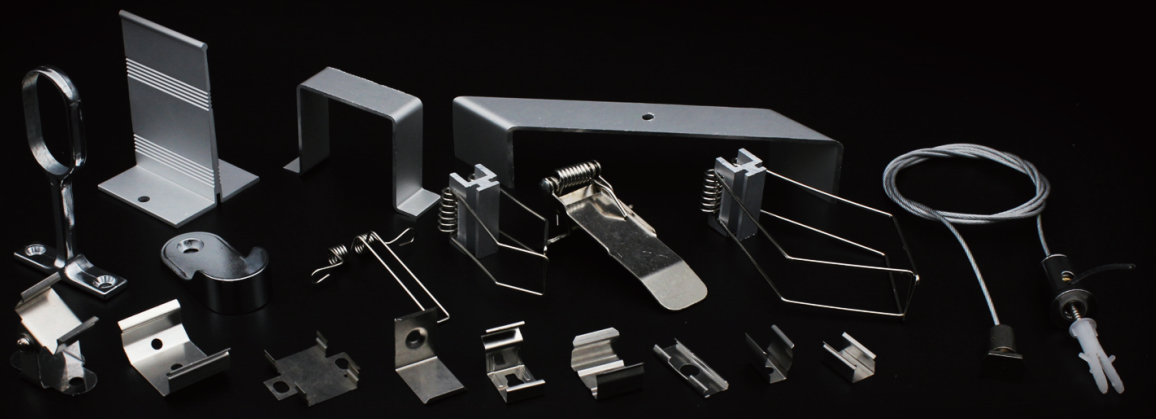
5. Accessories
Straight/- connector, L connector, + connector, and T connector support LED aluminum profiles to achieve various connections.
Why Chooce LED Aluminum Extrusion Profile?
• Linear light, Aesthetic, Protect the LED strip
The aluminum profile is rigid and has a linear strip shape, adding aesthetics to modern decoration. It is the best tool for linear lighting.
The light strip is hidden in the aluminum channel, very suitable for users who don't want to see the bare light strip, and it can also protect the light strip from dust.
• Heat dissipation
LED strip may accumulate heat due to its own or external reasons, and it is not dissipated in time, which will greatly reduce the LED's life.
In such an environment, we generally recommend that users install the LED aluminum channels for the light strips as heat dissipation channels.
The heat of the LED is fatal to the light strip. Even when the strip light is directly installed, care must be taken to prevent the light strip from overheating.
• Soften LED light, Uniform light, No spot
The LED brightness sometimes makes people feel very dazzling. Installing the light strip in the aluminum channel can not only solve the problem of LED dazzling, soften the LED light, and protect eyesight. But also make the LED light distribution more uniform and achieve the light effect of no spot.
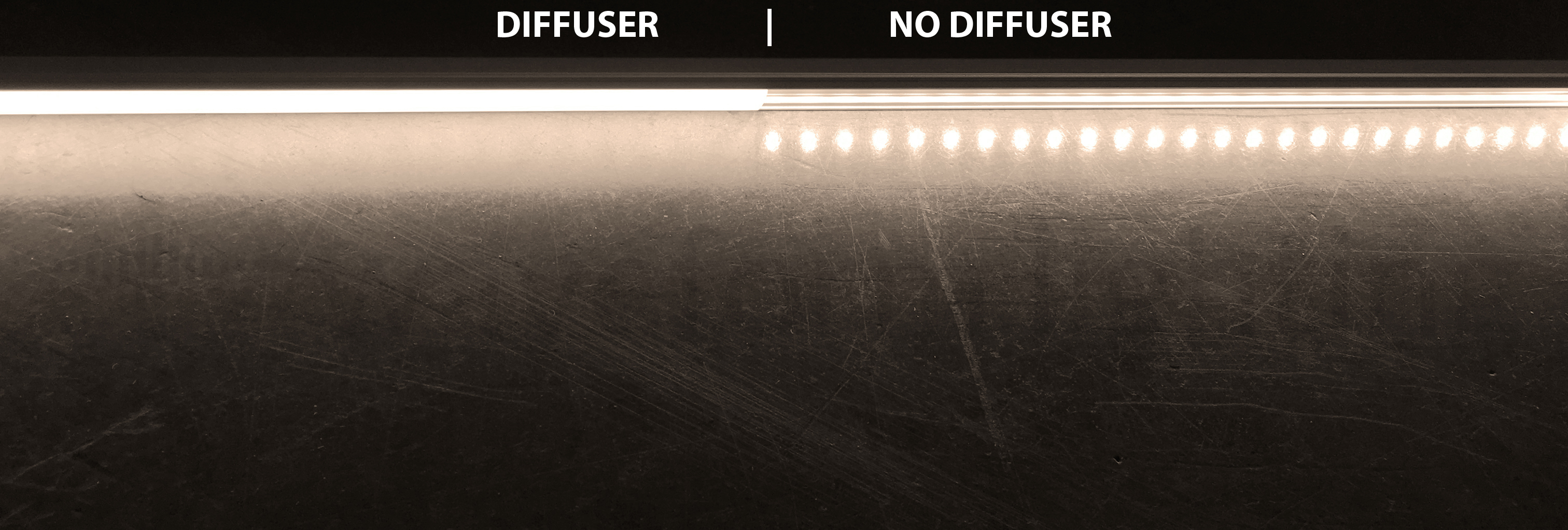
• Suitable for any LED strip light
Any type of LED strip llight can use aluminum extrusions as installation accessories, whether it is a single color LED light, tunable white, RGB, RGBW, RGBCCT, addressable LED strip, or waterproof LED strip lights.
*More LED strip light knoledge you may want to know:
Top 6 Considerations Before Buying LED Strip Lights
How to choose the right color for your led strip lights?
Ultimate Guide to Choosing the Right Addressable LED Strip
LED Aluminum Profile VS COB LED Strips
Regarding LED linear lighting, in addition to the LED aluminum profile, we will also think of COB LED strips. Both the aluminum profiles and the COB light strips can realize the no-spot lighting effect of the LED lights. What is the difference between them?

The COB LED strips have a linear lighting effect due to their own production process, so no additional accessories are needed. The COB light strip is installed through adhesive, and it has waterproof and non-waterproof options, available indoors and outdoors.
However, the aluminum profile is different. As the LED light strip accessory, the aluminum profile is equivalent to the protective cover of the light strip, which wraps the light strip to isolate the external environment. Therefore, the aluminum profiles play a role in protecting the LED strip lights from dust and moisture, and heat dissipation for the LED strips.
Aluminum has good rigidity, which is convenient for LED strip lights to be fixed in a straight line. While COB LED strips are more flexible to use, you can wind and bend the COB strip at will.
IP20 non-waterproof COB light strip is naked with the PCB board exposed to the air, and the installation environment has a greater impact on the strip. Overheating of the COB light strip will greatly reduce the light strip life. Adding aluminum channel to the LED strip lights not only dissipates heat, but also has a more beautiful installation effect.
| No Light Spot Linear Light | |
| LED Aluminum Profile | COB LED Strips |
| LED strip light accessory | LED strip light |
| Rigid (a straight line) | Flexible (wind and bend at will) |
| Heat dissipation, Dust-proof, Moisture-proof, Soften LED light and protect vision | Risk of overheating, backlog of dust, and humidity |
| Non-waterproof | Non-waterproof and waterproof options |
| Various types and shapes (U shape, circle, corner, etc.) | Strip |
| More beautiful installation effect | Light strip exposed to the air |
*Related LED strip knowledge you may want to know:
LED Aluminum Channel VS LED Neon Tube
Both aluminum channel and LED neon tube can play a role in protecing the LED strip lights from damage.
However, the LED neon tube is more flexible than the aluminum channel, and it can be created in various shapes, which are commonly used in advertising signs.
Moreover, LED strip lights placed in the neon tubes can reach IP67 waterproof level.

*LED strip light knowledge you may want to know:
How to Install LED Aluminum Profiles?
Owing to LED strip light itself having adhesive, the light strip can be pasted in the aluminum channel after the adhesive is removed.
Then cover the led light strip diffuser and the end caps. Fix the mounting clips with screws and snap the aluminum channel into the clips. In this way, an aluminum profile is installed.
This is the easiest way to install the aluminum profiles. Following are the other installations of the aluminum profiles.
Surface Mounted Series Aluminum Profile
The aluminum profile that is fixedly installed on the surface of the object is called surface mount. Our above-mentioned installation is the surface installation method.
It is also one of the most common installation methods of the aluminum extrusions. Commonly used in retail lighting and furniture.
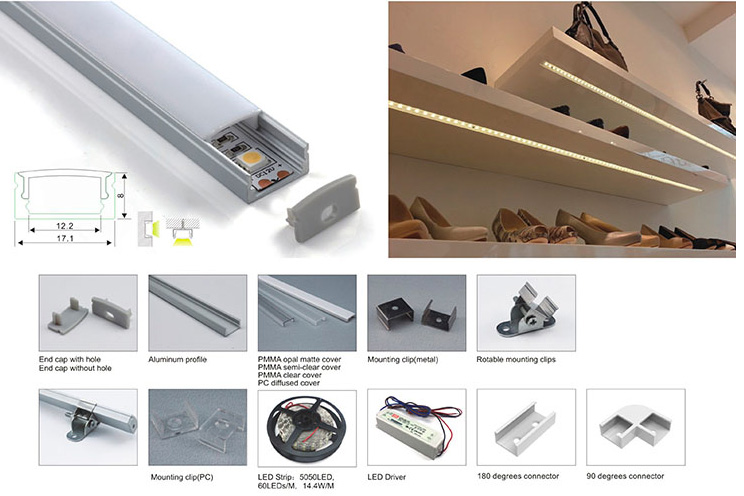
Recessed Series Aluminum Profile
The aluminum profile is embedded in the wall, furniture, or ceiling, just like the object itself can emit light.
LED aluminum profile recessed mounting needs to reserve the size when decorating, and choose the size of the aluminum profile according to the reserved size.
These LED aluminum profiles can be used in various different materials and environment.
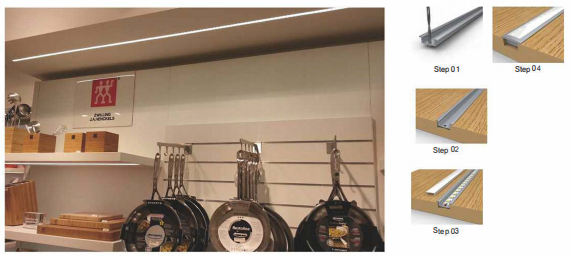
Suspending Series Aluminum Profile
The aluminum shape of the suspended series aluminum profiles is different, which supporting mounting clips and steel suspension kit to be suspended when installed. Can be used as an LED pendant light.
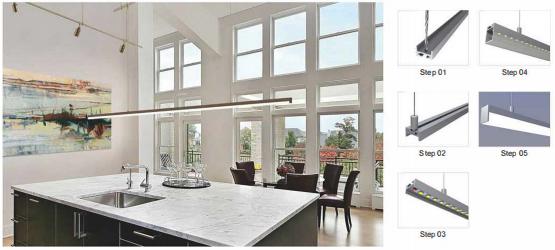
Angular Series Aluminum Profile
The 90 degree angle is a common bending angle of the aluminum profiles, which is commonly found in architectural modeling and decoration.
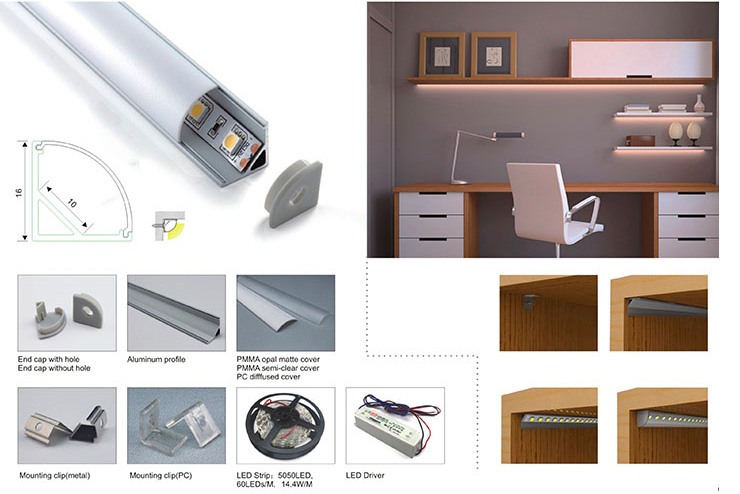
Mini Series Aluminum Profile
Most of the mini-series aluminum profiles are U-shaped, which supports surface mounting and recessed mounting, and are greatly suitable for home lighting projects.
Floor Series Aluminum Profile
Thickened aluminum can be used on the ground to prevent deformation when stepped on. In-floor inlays and stair treads are common ways for aluminum channels to be installed on the ground.
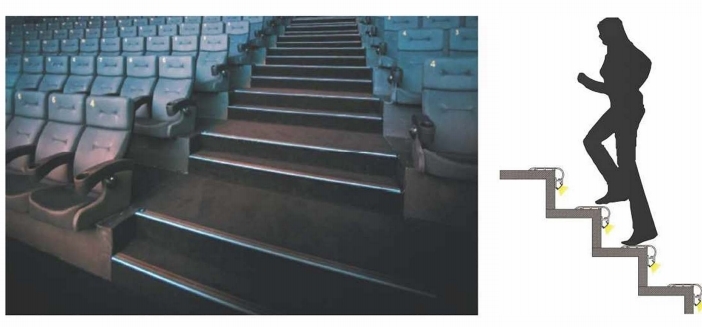
Special Series Aluminum Profile
In order to match various usage scenarios, different special-purpose aluminum profiles came into being.
With special structural design, the aluminum profiles can have a certain flexibility, and you can bend the different shapes at will.
Conclusion
In short, LED aluminum channels and LED strips are often used together in many modern lighting applications. Adding aluminum channels to your LED strips can not only increase the service life of the strips, but also allow you to enjoy better lighting effects.

